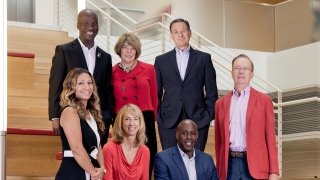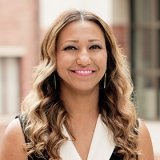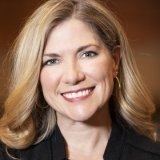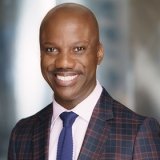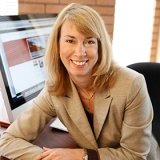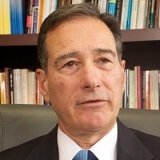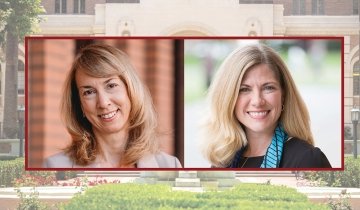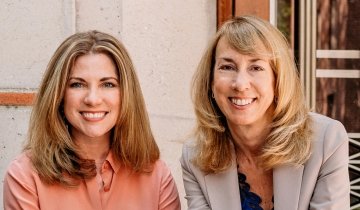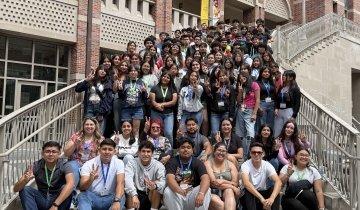Standing in front of a room full of higher education professionals this September, Associate Professor of Education Darnell Cole told the audience that students should not bear the responsibility for creating equity on campus.
“This is what we get paid to do — faculty, staff alike,” Cole said. “We get paid to understand our student populations, and that requires something of us. … This is an ongoing professional responsibility that sometimes we're not held accountable to.”
Students had gathered alongside professionals for a summit on “(de)Institutionalizing Islamophobia” on campuses, led by the Center for Education, Identity and Social Justice at USC Rossier. Cole co-directs the center with Associate Professor of Clinical Education Shafiqa Ahmadi, who told students at the summit that they have the ability to use their voices “to bring these issues to bear.”
Together, the co-directors emphasized a point backed by research: Faculty members are essential to promoting equity at institutions. But even when people recognize this, there are often many obstacles in the way of bringing equity work to fruition.
KNOW THE PROBLEM
Inequities on campuses show up in data and anecdotes alike. Even as students of color make up a greater percentage of enrollees, college faculties are still predominantly white (79 percent), according to the most recent estimates from the National Center for Education Statistics. Students of color make up 50 percent of students at two-year colleges, but only 39 percent of students at four-year institutions. Men still outnumber women in top administrative and faculty positions. Stories about explicit and implicit bias permeate the news on campuses large and small.
Identifying and calling out such inequities is a crucial step, experts say.
“I think we have to name race, I think we have to name our own culpability in systems that are bigger than ourselves,” says Julie Posselt, an assistant professor of higher education and a faculty member of the Pullias Center for Higher Education at USC Rossier. Posselt, who studies graduate school admissions, says that she’s seen such themes emerge time and again in her research.
“We have to be willing to reflect on the ways our everyday behavior helps reproduce bigger systems — habits, routines, seemingly small things can make a big difference,” she says.
Even when the problem is recognized, though, knowing how to address it can be problematic.
“I think people don’t have good role models and examples of how this kind of work can be done,” says Shaun R. Harper, director of the USC Race and Equity Center.
Born in rural Georgia, Harper was raised in a segregated town. He says his family made clear their expectations for him — that he wouldn’t waste his education by failing to support those facing discrimination.
Under Harper’s leadership, the USC Race and Equity Center visits colleges and universities struggling with racial issues.
“My great-grandmother would be turning over in her grave if I were sitting here as a tenured professor writing stupid papers about pointless questions that absolutely do nothing to liberate and improve conditions for black people and other people of color and gay and lesbian people,” Harper says of his role as a faculty member. “I feel an enormous amount of responsibility to my people.”
Other institutions have turned to the Center for Urban Education, run by Estela Mara Bensimon, a professor of higher education. More than 100 colleges and universities have used CUE’s Equity Scorecard to determine how well those institutions address equity concerns.
“I take the approach that people don’t know how to be equity-minded or critically race-conscious,” Bensimon says. CUE established the term “equity-mindedness” to describe actions that demonstrate individuals’ capacity to recognize and address the structures, policies and practices that create and sustain racial equities.
Often, Bensimon says, administrators and faculty mistake diversity for equity, which has been the case since she came to USC two decades ago.
“At that time the talk was always about diversity, and no one was worrying about the fact that community colleges here in California — and in the Cal State system — already had diversity, but it didn’t mean they were producing equitable outcomes for the students who created their diversity,” Bensimon says.
DIMINISHING SUPPORT
Another obstacle to improving equity on campus is that it often falls to tenure-track or clinical faculty, who are the most invested in campus culture, according to Professor of Education Adrianna Kezar, co-director of the Pullias Center for Higher Education.
But here’s the problem: Across the United States, 70 percent of faculty members are now adjuncts. Because those adjuncts often work for low pay and aren’t part of a university’s shared governance structure, Kezar says they often are excluded in the kind of crucial cultural work that could benefit from their involvement.
“Somebody like an adjunct probably doesn’t see much of a role in creating culture,” Kezar says. “Because if you want to have a role, you want to feel like part of campus culture — you need engagement. I think a lot of adjunct faculty don’t feel valued or part of culture.”
According to Kezar, adjunct faculty usually don’t have access to regular professional development, don’t get regular evaluations, don’t have job security and are unlikely to invest in a curriculum if they won’t be there the next semester. Even faculty unions have been historically reluctant to embrace adjuncts as members.
“How are we being effective as institutions when the very workforce that we’re hiring is counter to being effective?” Kezar says.
Kezar adds that tenure-track faculty members have a role in bringing adjuncts into the fold, whether through advocating for them in governance models or in simpler ways like mentorship. Advocacy groups representing non-tenure-track faculty, like New Faculty Majority, stress the lack of support for students of color and adjuncts, trying to illustrate the connections between different inequities and hierarchies that do not serve higher education.
ENTRY PROBLEMS
In addition to bringing in colleagues, faculty members may also have to prepare graduate students to be conscious of equity issues before they become professors — but that’s easier said than done.
“You’re socialized as a graduate student not to take risks,” says William G. Tierney, Wilbur-Kieffer Professor of Higher Education and co-director of the Pullias Center. “You’re supposed to wait to take risks, and you always wait.”
Tierney says that moving up the academic ladder, from PhD student to assistant professor to tenured professor, means keeping the waters calm.
“By the time you’re an endowed chair you start worrying about the seating at the holiday party, if you’re going to end up sitting at the president’s table or out in Siberia, and that means you never take a risk,” he says.
Faculty members can be agents of change on their campuses and in the nation. They can mentor their own students, and work with students in other schools. But that’s not happening for the most part, Tierney says.
“If we thought everybody was unteachable, we would be very demoralized,” Bensimon adds. “We have a lot of privilege, we have a lot of power in the positions that we’re in, and it is important to think about how you use it — not only on behalf of yourself but on behalf of others.”
More than anything, perhaps, experts say that a faculty has to be united in doing the hard work of equity, even if it takes time.
“The power of a group of faculty deciding together that they want to make something happen is quite remarkable,” Posselt says. “Individual faculty working on their own can be really effective and are highly competent professionals, but faculty members working together have a much greater collective influence.”
*Photo
Standing, from lower left:
- Shafiqa Ahmadi, assistant professor of clinical education and co-director of the Center for Education, Identity and Social Justice
- Shaun R. Harper, Clifford and Betty Allen Chair in Urban Leadership and executive director of the USC Race and Equity Center
- Estela Mara Bensimon, professor of higher education and director of the Center for Urban Education
- Jerry Lucido, professor of practice, associate dean of strategic enrollment services, and executive director of the Center for Enrollment Research, Policy, and Practice
- William G. Tierney, Wilbur-Kieffer Professor of Higher Education and co-director of the Pullias Center for Higher Education
Sitting:
- Adrianna Kezar, professor of education and co-director of the Pullias Center for Higher Education
- Darnell Cole, associate professor of education and co-director of the Center for Education, Identity and Social Justice

